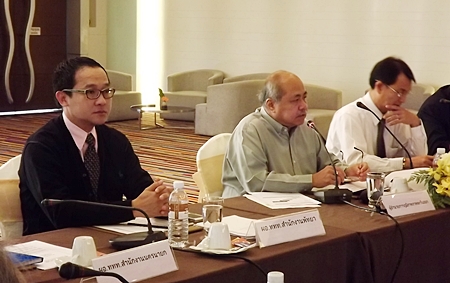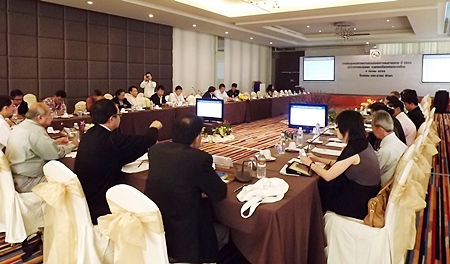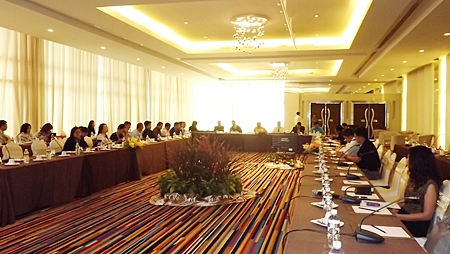The Tourism Authority of Thailand hopes to attract 22 million foreign visitors to the Eastern Seaboard by 2019 with families, big spenders and long-staying visitors the prime targets.
At a March 6 planning meeting at the Zign Hotel, TAT officials from its four eastern offices – Pattaya, Rayong, Trat and Nakhon Nayok – also began mapping out marketing plans for 2013.
 (L to R) TAT Pattaya Director Athapol Vannakit, TAT Eastern Region President Borisut Prasopzup, and Eastern Region Marketing Director Kritsada Rattanapong.
(L to R) TAT Pattaya Director Athapol Vannakit, TAT Eastern Region President Borisut Prasopzup, and Eastern Region Marketing Director Kritsada Rattanapong.
After years of political strife that depressed tourist arrivals, the TAT is optimistic again, buoyed by sequential growth in the two last quarters of 2011 due to relocation of flood evacuees to the region and Pattaya’s parade of holiday events.
TAT Eastern Region President Borisut Prasopzup said the organization’s new goal is to make the Eastern Seaboard one of the three most popular tourist destinations in Asia. More of Pattaya’s traditional western “cheap charlie” tourists, however, is not what it’s after.

By 2019, he said, TAT wants to see a 9 percent increase in international tourists but a 15 percent increase in international tourist revenue. The domestic-market target is a 4 percent increase in visitors with a 7 percent increase in their spending. The 2019 target calls for 22 foreign tourists and 105 million Thai visitors. TAT wants a 7 percent increase in overall tourist revenue in 2013.
Eastern Region Marketing Director Kritsada Rattanapong said the agency will begin reaching for those goals in 2013 by focusing on “increasing the value” of the tourist market. Marketing and promotion, he said, should target tourist groups with the highest spending power, particularly families and long-stay visitors.
“The eastern region is considered ideal for family vacations and is a convenient connection point with Thailand’s central and Issan regions,” Kritsada said. “The east also has many natural tourist attractions and is fully capable of accommodating guests for events, seminars and academic research.”
At the same time TAT is targeting big-money tourists; however, it needs to create “emotional value” for tourists, Borisut said. That comes from working with partners, forming networks, strengthening relationships and coordinating with international tourism groups to “convert crisis into opportunity by turning rivals into partners to increase marketing opportunities as the Association of Southeast Asian Nations prepares to unify the market in 2015.”
Initial promotions for 2013 include the “Tasty, Crisp, Sweet and Shiny Town of Fruits” campaign in April to June of next year, the “Colorful Adventures” campaign that begins in October and runs through September 2013, and the “Swing Duel Golf” event running from March to May of next year. The TAT Eastern Region also launched a website to promote its activities at TravelEastThailand.org.
Of course, plans for 2013 also include the usual trade shows, “road shows” and travel agent trips. Regional tours and environmental tourism will also play large roles in next year’s plans, officials said.
Borisut said the key to the near- and long-term plans, however, will be the cooperation of the private sector. While public-sector entities like TAT can lay out guidelines and act as the “commander” for the tourism industry, hotels, tour operators, travel agents and others in the private sector must take up the challenge if the east’s tourism industry wants to improve its economic prospects, he said.





